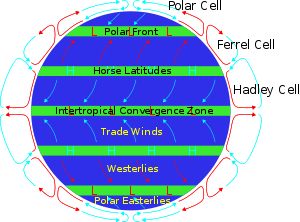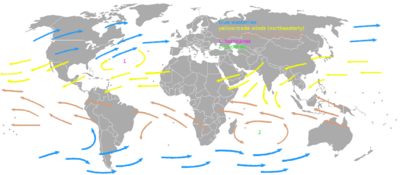Global wind patterns


Global wind patterns: Winds are named by the direction from which they blow. The globe is encircled by six major wind belts, three in each hemisphere. From pole to equator, they are the polar easterlies, the westerlies, and the trade winds. All six belts move north in the northern summer and south in the northern winter. Each belt occupies about 30 degrees of latitude, that is, one third of the way from the pole to the equator.
Polar Easterlies: At about the latitude of Norway and northward (60-90 degrees), the Polar easterlies blow irregularly from the east and north.
Polar Front: Between the polar easterlies and the westerlies is the polar front.
Prevailing Westerlies: At about the latitude of Western Europe and the U.S. (30-60 degrees), the Westerlies blow from the west, tending somewhat toward the north. This causes most weather in the United States to move from west to east.
Horse Latitudes: Where the Westerlies meet the trade winds at about 30 degrees (Jacksonville, Florida) is the Horse latitudes, also Variables of Cancer, Subtropical High, or Subtropical ridge. This is a region of high pressure, dry air, and variable winds, and is associated with deserts over land.
Trade Winds: South of about 30 degrees the northern or northeast trade winds blow mostly from the northeast toward the equator. These were the sailor's favorite winds, since the weather was warm, and the winds usually blew steadily in an advantageous direction. Columbus used these to sail to the Caribbean.
Doldrums: At about the equator is Intertropical Convergence Zone or doldrums, a region of light and irregular wind broken by occasional thunderstorms and squalls. The width and exact location of the doldrums is hard to predict. Sailing ships are sometimes becalmed here for many days waiting for a proper wind.
Southern hemisphere: In the southern hemisphere the belts are reversed. The southeast trade winds blow from the southeast toward the equator. The southern equivalent of the horse latitudes (or Variables of Cancer) is called the Variables of Capricorn. The southern westerlies start somewhat south of South Africa. They tend to be stronger than the northern westerlies because they are mostly over water (roaring forties). The southern polar easterlies are mostly over Antarctica.
Seasonal shifts: All of the belts move north during the northern summer and south during the northern winter. Because global heating and cooling lags behind the position of the sun, they reach their northernmost latitude at or after the end of the northern summer. This brought the trade winds within reach of the Spain and Portugal and determined the sailing time of the Spanish treasure fleet. The northernmost position of the wind belts corresponds to the Atlantic hurricane season.
Land and sea breezes: Land gains and loses heat more rapidly than water. During the day, the land warms more rapidly than the water. The air above land warms, becomes thinner, and rises, drawing cooler air landward from the sea. At night, the process reverses, and cool heavy air from the land flows out to sea. These land and sea breezes are important along the coast.
Monsoon: The annual equivalent of the daily land and sea breezes is the yearly monsoon. During summer, the continents heat more rapidly than the oceans. Air over the continents warms, thins and rises drawing cooler moist ocean air landward, producing a wet season. During winter, the process reverses and cold, dry heavy air flows outward from the continents, producing a dry season. The monsoon is most striking in south Asia because of the size of the Eurasian landmass and because the Himalayas tend to bottle up the air above the continent. Approximations of the Indian monsoon exist in other places, but they are poorly developed.

Ocean Gyre: The fact that the westerlies and trade winds blow in opposite directions and that the continents prevent water from circling the globe contributes to the formation of circular ocean currents, clockwise in the northern hemisphere and counterclockwise in the southern hemisphere. The Coriolis force also plays a part. The trade winds push water west. At the doldrums it flows back east producing the equatorial countercurrent. See Ocean gyre.
Coriolis force, Hadley cell and other things: In the northern hemisphere, the Coriolis effect causes wind and water currents to bend to the right (clockwise). Cold heavy air flows south from the north pole and is bent west, forming the polar easterlies. Warm air rises at the equator drawing air from the north which bends to the west, contributing to the trade winds. The Coriolis effect bends the westerlies and trade winds slightly clockwise in the northern hemisphere.
Hot air rises at the doldrums. As it rises, it cools producing thunderstorms. The dry air flows north at a high altitude and descends at the horse latitudes and flows back to the equator with the trade winds. This is called the Hadley cell. There is also a Ferrel cell over the westerlies and a polar cell over the pole. There are other complexities, not all of which are properly understood.